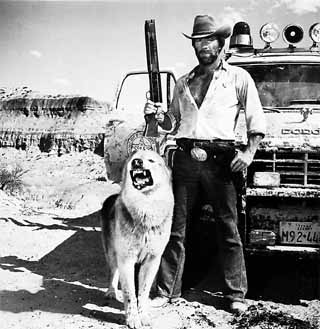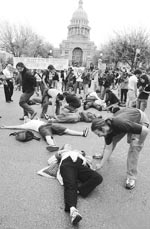The Last Texas Ranger
They don't make 'Rangers' like Walker anymore.
By Lucius Lomax, Fri., Oct. 26, 2001

If you've never seen a real Texas Ranger, your first glimpse might be surprising. Not long ago a Ranger sergeant bumped into me in a hallway in downtown Austin. The middle-aged lawman didn't at all fit the Western ideal. Short, round at the edges, eyeglasses, a sales clerk's manner: He could just as easily have been the owner of an auto parts store on I-35. The only traditional features were the shiny boots and 10-gallon hat -- but you'd see pretty much the same thing at any local honky-tonk on a Saturday night.
Contrast the image of the frumpy sergeant with Captain Barry Caver, commander of Ranger Company E in Midland. Captain Caver had his first major exposure to the public a few years ago during the Republic of Texas standoff in the Davis Mountains. Tall and sharp at the edges, not round, the captain wears suits that look as if they came from a tailor instead of off the policeman's rack. Dress is more important in Midland than in laid-back Austin, but it's not merely a question of geography, or of rank. The Rangers are a more mixed group than they used to be. The division's 103 officers are still predominantly white men (somewhere between the extremes of the statuesque captain and the soft-edged sergeant) but there are now 14 Hispanic males, four black males, one white female, one black female, and one Chinese-American -- a certain Sgt. Shing in Garland. Times have changed.
They just haven't changed much. It's not surprising that in 1993, when Hollywood decided to create a television series based upon the adventures of a "contemporary Texas Ranger," the producers chose the captain's image, not the frumpy sergeant, much less the Asian officer in Garland. When Walker, Texas Ranger (starring martial arts expert and B-movie idol Chuck Norris) debuted, anyone with half a brain would have guessed that the weekly series could not survive a full season. It seemed a weird cowboy throwback -- half-western, half-martial arts movie -- featuring actors so wooden and scripts so dopey that even the hard-core action fans wouldn't fall for it.
Who knew? Eight years and nine seasons later, the last episode aired early this summer, and the cast and crew didn't head for the last roundup because of any drastic decline in ratings, but because, in a phrase: They were tired of success.
The Hollywood-Texas Connection
Now that the suffering is over for the rest of us, it's time to find out who was responsible for this particular crime. The state of Texas, it turns out, was one of the major conspirators.

It's tempting to blame Walker, Texas Governor, for Walker, Texas Ranger. But the series was already in production two years before George W. Bush moved into the Mansion. The real culprit was Ann Willis Richards. Governor Richards did time with the glitterati in California. She played the good ol' girl for the West Coast cameras: as the female governor of the most macho state in the Union, she herself became a kind of walking movie script. "She's governor of Texas," hometown critics liked to say of her frequent trips to Tinseltown, "not mayor of Los Angeles."
Although Richards' image was a large part of her political appeal, the Hollywood-Texas connection really served a more substantial purpose. "She liked movie people and they liked her," explains one of Richards' former aides, who observed the governor in L.A. "But it wasn't just that she enjoyed hanging out with movie stars. There was always an underlying reason [for her visits to California]. She was trying to bring production to Texas." In this case "production" was not oil but celluloid.
The benefits to the state of movie and television filming were two-fold. Of course there are the salaries and expenses of filmmaking, which can be considerable. In the case of Walker alone, estimates during the series' early years were that each episode cost approximately $1.4 million to produce (multiplied roughly 25 times per season), a figure that approached $2 million per show toward the end of the run. Those are television executives' figures, which probably need to be judged with a healthy dose of skepticism, but during the Richards' administration there's no doubt that dollars spent in Texas on film/television production more than doubled. Equally important was the "legitimacy" that Hollywood lent to Texas -- adding a little polish and sophistication to a state otherwise known for the weird and dangerous, and also making easier the governor's job of attracting less glamorous business. Richards' role in the refinement of the state's industrial base should not be underestimated.
According to correspondence now collected in the governor's film office, as early as Richards' 1991 inauguration producers had already begun to scout Texas locations for a Rangers-based series. The executives expressed an avid interest in meeting real live Rangers in every city they visited, a wish that was presumably fulfilled (although not documented in the files). At the same time the new governor's staff began anticipating the next step -- pushing Texas product placement on screen. "If you're interested we might be able to secure some things for the show," one of Richards' aides wrote to Cannon Television in October 1992. "In particular, doesn't Chuck Norris' character drive a truck? (I know there's a continuing story line about his car, but I don't recall the details.) GM makes a 3/4-ton truck that runs on compressed natural gas -- I think we could get one for the show if its 'CNG' feature could be featured in some way. Any way to fit it in?"
Besides natural gas, the "approved" list of Texas-made products for television placement grew to include Levi's, Justin Boots, Shiner Beer, Artesia Water, Big Red, Stetson hats, Dell computers -- and of course General Motors. Unfortunately for GM -- considering the endless close-ups of Walker's truck pulling its horse trailer -- General Motors' Arlington plant produced Chevrolets, Buicks and Cadillac Fleetwoods, but no pick-ups. (The show's soundtrack also became a locus for Texploitation. "I've left word for my Lyle Lovett contact," the same aide wrote, "but haven't reached him yet. ... I urge you to look at two other Texas artists, Robert Earl Keen and Mark Chestnutt. If you want tapes, holler and I'll get them to you. USE A TEXAS ARTIST!")

Governor Richards kept a close eye on overall progress. The two-hour pilot, titled "One Riot, One Ranger" -- you don't want to know the plot -- aired in early 1993 and, as full production began, the governor wrote to the show, "I hope you'll let me know whatever my office can do to make this a successful shoot for everyone involved." Governor Richards had already offered to visit the set. Later, in April of the same year, there was another note from the capital: "I hope that you'll have good news from the network soon." Alas -- CBS picked up the series.
Suburban Indians and Winking Sheriffs
The producers' need for state assistance quickly peaked and then leveled off, as filming became routine in and around Dallas. Occasional help was still solicited and given. The Department of Public Safety juggled regulations to allow the show's producers right of first refusal for buying seized autos at state auction. (There were car crashes and chase scenes to shoot, so why not make bad guys provide the vehicles for the Rangers' glory?) Filming at a state jail was made available -- then curtailed after an inmate escaped. The state agency that had to bear the brunt of "assistance" was not the Dept. of Criminal Justice or Public Safety, but Transportation, TxDOT, which had to close roads for scenes of Walker in his truck, and allow placement of fictitious highway signs such as "INDIAN RESERVATION," to convince viewers worldwide that suburban Dallas has a continuing role in the Old West.
Of course permits were always required -- but not always obtained. An anonymous aide in the Governor's office recorded notes of a telephone conversation with Walker's staff: "So far," the aide wrote, "[the producers] haven't had problems because, confidentially speaking, they shoot anyway, even if TxDOT hasn't officially approved it. [A producer] says that TxDOT folks in Collin County said, off the record, 'As long as you have the sheriff in on it, we don't care.'" In addition to the sheriff it helped to have the Governor "in on it." Richards can't really be blamed if Walker was just another bad cop show; her success was in opening Texas to the film and television industries. And in return for her help, the only favor that Ann Richards asked was that any time the governor of Texas was mentioned on Walker, the state's chief executive was to be referred to as "she."
In June of 1994, after the series had become well-established, "she" wrote to the show's crew: "Congratulations on another great season. Walker, Texas Ranger has been great for Texas, and I hope it runs for twenty or thirty seasons." Although not quite a decade, the television series' run, in actuality, turned out to be longer than the governor's.
Walker Stiffs Walker
In 1996 the Walker producers attempted to lure George Bush onto the show, to play himself. "We at Walker, Texas Ranger would like to extend a heartfelt invitation for Governor Bush to appear as himself in an upcoming episode. We are enclosing the script pages showing the anticipated scene in which we would like Governor Bush to appear," the casting director wrote to Karen Hughes, then-gubernatorial director of communications, now counselor to the president. "Mr. Norris and the director, Tony Mordente, would be willing to modify the dialogue if the Governor has any objections to the script as it is written."
But George Bush declined the opportunity to take his act before the cameras. It was a peculiar refusal, considering that Chuck Norris is a self-described admirer of the elder George Bush's term in the White House. In any case, the proposed lines the commander-in-chief was to have read have been "lost" to posterity, according to the governor's film office. But for the sake of the historical record -- the title of the proposed Bush episode, which apparently never aired -- was "Deadline."
As for the real Rangers -- those 103 sometimes-frumpy, sometimes-stylish, gun-carrying, mostly white men -- Walker has been a mixed blessing. On occasion bad guys (as well as some babes, in bars, late at night) have been willing to surrender just because of the honor of being pursued by the Texas legend. In other ways, however, the era of Walker's success has not been the best of times for this particular law enforcement elite. A few years ago the chief of the Rangers was fired, after an accusation of too much schmoozing with legislators. His successor "retired" recently, after the Rangers were outsmarted by the prison escapees known as the Connally Seven. A year or two ago, the capital's best-connected legal firm, Minton & Burton, presented a bill for almost $400,000 to the Dept. of Public Safety -- expenses primarily incurred while defending the Rangers' supervisors against employees' lawsuits.
Meanwhile, the Ranger division has been slowly evolving to meet the modern age. The romantic days of riding the Mexican border, enforcing Austin's will, are past. That fact was brought into sharp focus during the Republic of Texas siege in 1997, as the Rangers -- dressed in combat fatigues, some of them overweight and out of shape -- tried to hump it across the Davis Mountains.
As the Rangers are caught between an increasing urban population and their own rural roots, stresses are evident: Not long ago, an elderly Ranger serving in the Panhandle communicated joyously to headquarters that he had finally mastered his laptop. And in an effort to catch up with the sensibilities of the rest of society, the Department of Public Safety recently spent $61,000 -- primarily in the form of a grant from Governor Rick Perry's office -- to hold a class for the Rangers on investigating crimes against women. That precise subject just happened to be one of the frequent themes of Walker's nine-season run: Perry and the Rangers were just trying to keep up with the Hollywood scriptwriters. And if you needed any additional evidence that life now imitates television "art": The Ranger class was taught by a member of O.J. Simpson's defense team. ![]()
Got something to say on the subject? Send a letter to the editor.








